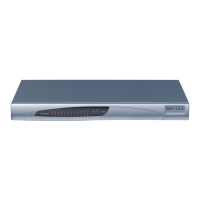3. IP Routing table: Two routes are configured for directing traffic for subnet
201.201.0.0/16 to 192.168.0.2, and all traffic for subnet 202.202.0.0/16 to 192.168.0.3:
Table 11-3: Example of IP Routing Table
Destination IP
Address
Prefix Length Gateway IP Address Metric
201.201.0.0 16 192.168.0.2 1
202.202.0.0 16 192.168.0.3 1
4. The NTP applications remain with their default application types.
11.2.5.2 VoIP Interface per Application Type
This example describes the configuration of three VoIP interfaces; one for each application
type:
1. Multiple Interface table: Configured with three interfaces, each for a different
application type, i.e., one for OAMP, one for Call Control, and one for RTP Media, and
each with a different VLAN ID and default gateway:
Table 11-4: Example of VoIP Interfaces per Application Type in Multiple Interface Table
Index
Application
Type
IP Address
Prefix
Length
Gateway
VLAN
ID
Interface Name
0 OAMP 192.168.85.14 16 0.0.0.0 1 ManagementIF
1 Control 200.200.85.14 24 200.200.85.1 200 myControlIF
2 Media 211.211.85.14 24 211.211.85.1 211 myMediaIF
2. VLANs are required and the Native VLAN ID is the same VLAN ID as the
Management interface (configured for Index 0):
• 'VLAN Mode' is set to Enable.
• 'Native VLAN ID' field is set to "1".
3. IP Routing table: A routing rule is required to allow remote management from a host
in 176.85.49.0 / 24:
Table 11-5: Example IP Routing Table
Destination IP
Address
Prefix Length
Gateway IP
Address
Metric
Interface
Name
176.85.49.0 24 192.168.0.1 1 -
4. All other parameters are set to their respective default values. The NTP application
remains with its default application types.

